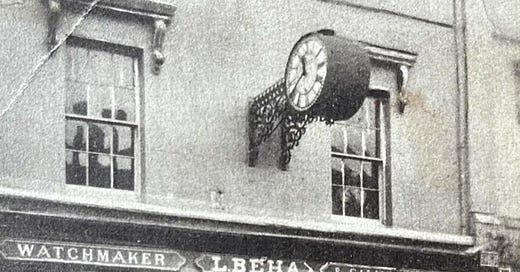The Travelling Watchmaker | Leander Beha
In this article, I explore the life of a German man who became one of Bridgend’s most beloved Watchmakers and was responsible for its most famous landmark.
Baptised on the 27th of February 1840, Leander Beha was a son of Anton and Helena Beha of, Baden-Württemberg.
In 1857, at seventeen, Leander and his older brother Maximillian left Germany for Britain. For the first few years of their lives in Wales, both brothers worked as ‘Travelling Clockmakers.’ The brothers eventually parted ways, with Maximillian moving to Llanelly to work for a German Clockmaker.
The first record of Leander being in Bridgend can be found in the 1861 census. The census record tells us that Leander, then aged 21, was boarding at the home of Thomas and Elizabeth Arnott of Nolton Street. His occupation is given as ‘Clockmaker.’
In June 1866, Leander established his business and workshop at Dunraven Place. The earliest advertisement is found in The Central Glamorgan Gazette dated 29th of June 1866.
In it, he thanks the townspeople for their “liberal patronage.” It describes his shop and workmen's services: Watchmaking, clockmaking, jewellery, wedding rings, repairs and alterations.
Leander and his workmen became well-known and highly respected tradesmen. The workmen employed at Leander’s shop were mostly from a similar background to his. He employed watchmakers and apprentices from all over Europe. The majority of societies and public institutions relied on Leander’s services. This included supplying the workhouse with clocks, engraving and making awards. Leander and his workmen could do it all.
Due to water damage, the Randall Memorial Drinking Fountain’s ill-fitting clock was removed in August 1868. This left the inhabitants of Bridgend without a public clock. A few months later, Leander took it upon himself to erect a public clock above his shop.
Described as “a handsome double-faced clock” the dials were easily seen from Queen Street. It was hoped that the Bridgend Board of Guardians would light the clock at night but it is unknown whether this happened.
The 1871 Census tells us that Leander was living at Dunraven Place. His occupation is given as “Jeweller.” By this time he was employing a housekeeper. The electoral register records Leander owning a house and a shop at Dunraven Place.
In 1876, much to the benefit of the public, Leander replaced the now eight-year-old clock with a new state-of-the-art one. Although no longer illuminated, the clock is still in situ above ‘Zia Nina’.
The Central Glamorgan Gazette reported: “The dials are of very neat design, and so distinct that they can be seen beyond the limits of Dunraven-place. When the clock is illuminated at night it has a pretty and cheerful appearance. By an ingenious contrivance, the illuminating arrangements are self-acting, both for lighting and extinguishing.”
On the 27th of December 1876, Leander married Catherine Jones Cragoe at St Mary’s Church, Nolton. Eighter years his junior, Catherine (or Kate as she was known) was the daughter of Joseph and Elizabeth Cragoe. Kate’s parents were the Innkeepers at the Wyndham Arms Inn, directly opposite Leander’s shop.
Outside of his work life, Leander was involved in many local societies. He was a member of the Ogmore Lodge of Freemasons. He was initiated in 1878 and later became a Master Mason in 1886. He was a member of the Bridgend Rifle Volunteers Shooting Club. Starting as a Private, he was appointed Corporal in 1884.
Due to his Catholic upbringing in Germany, Leander was a staunch churchman. He was a member of St Mary’s Church, Nolton, and a member of the choir. He was involved in rebuilding the church, displaying the plans and notices in his shop window. After the church's completion, Leander gifted the church an oak eagle lectern - still in use today.
Leander and Kate’s only child was born on the 27th of February 1878. Hubert Leander Beha was baptised at St Mary’s Church, Coity, on the 15th of March but sadly died two days later. Hubert was buried at St Mary’s Church, Coity, on the 20th of March.
Sadly, it wasn't long before tragedy would strike the Beha household again. On the 17th of May 1879, Kate died after a short illness. Kate was buried alongside her son at St Mary’s Church, Coity, on the 21st of May. The Central Glamorgan Gazette reported: “..it has caused painful feeling among a large circle of friends and indeed, throughout the town.”
The 1881 and 1891 Census tell us Leander was living at Dunraven Place. After his sister Albertina's death in 1895, her sons Albert and Eduard travelled from Germany to Bridgend to live with their uncle. Albert and Eduard were skilled watchmakers and would have been a huge help to their uncle.
On the 1st of June 1899, after a severe attack of rheumatism, Leander died aged 59.
Leander was buried with his wife and son at St Mary’s Church, Coity, on the 5th of June 1899. His obituary described him as a “generous and kindhearted man.”
Following his death, his nephews Albert and Eduard took over the business. They worked alongside Leander’s business partner Edmund Needham and expanded the business by introducing other services including eye testing and making glasses.










What a delightful and informative article about a most interesting man. Thank you.
Great article and I inherited a wall clock with his name on the china face with bridgend also written on the face ..it works to this day June 2024